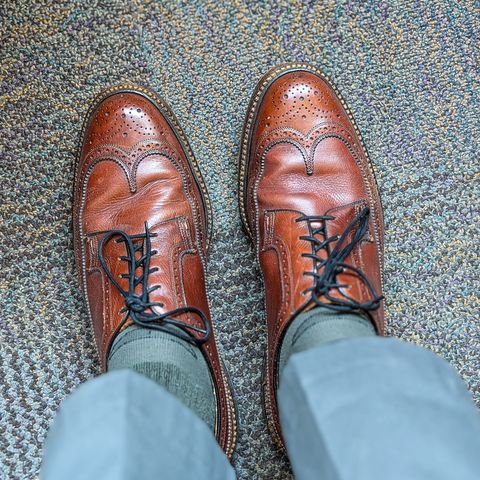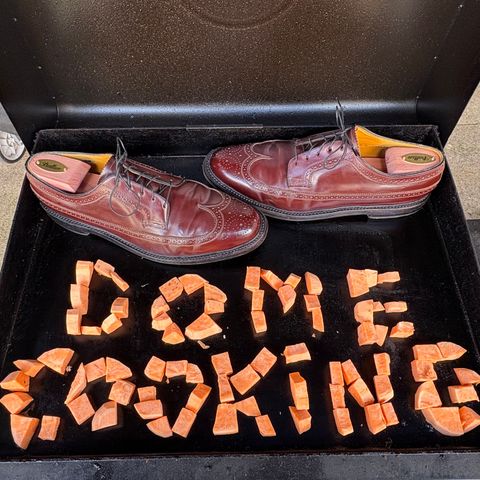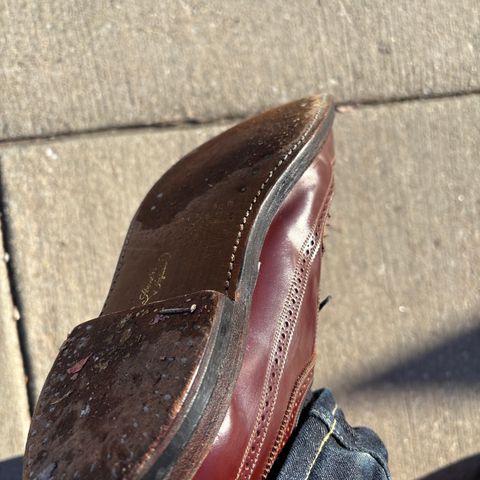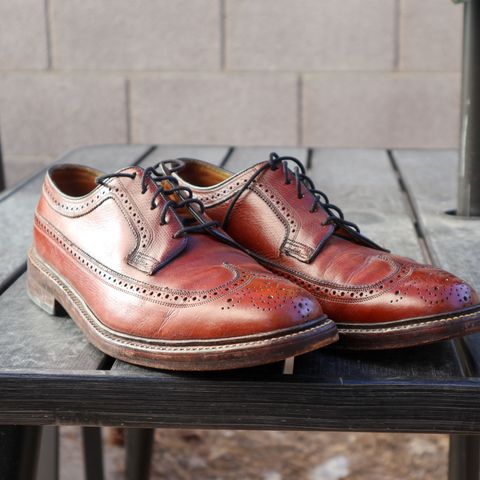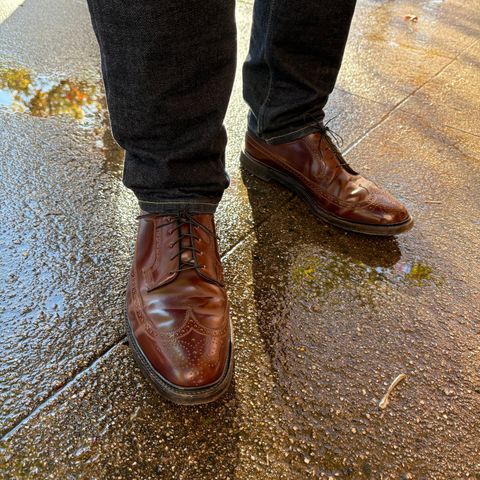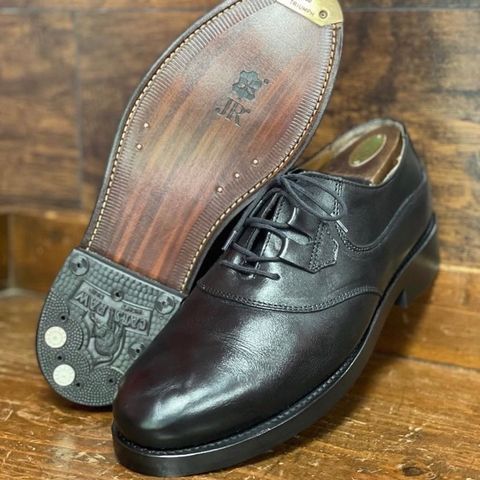Florsheim
MakerAbout
Florsheim is an American footwear company founded in 1892 by Milton S. Florsheim in Chicago, Illinois. The company established itself as a producer of high-quality men's dress shoes at moderate prices, gaining national recognition for craftsmanship and durability throughout the 20th century. Known for implementing traditional Goodyear welt construction methods, Florsheim became synonymous with American-made business footwear and formal shoes.
About
Florsheim is an American footwear company founded in 1892 by Milton S. Florsheim in Chicago, Illinois. The company established itself as a producer of high-quality men's dress shoes at moderate prices, gaining national recognition for craftsmanship and durability throughout the 20th century. Known for implementing traditional Goodyear welt construction methods, Florsheim became synonymous with American-made business footwear and formal shoes.
The brand is particularly renowned among heritage footwear enthusiasts for its vintage Imperial line, especially the Kenmoor model produced from approximately 1960 to 1988, which represented one of the finest examples of American shoe manufacturing. Following a period of ownership changes, Thomas W. Florsheim, Jr. and John W. Florsheim of Weyco Group repurchased the brand in 2002 for $47 million, returning it to family control under fifth-generation leadership.
History
Florsheim was established in Chicago in 1892 by Milton S. Florsheim, whose father Sigmund had settled in Chicago from Germany and worked as a shoemaker. The first Florsheim shoes were crafted by Milton and his father, establishing the foundation for what would become a nationally recognized brand. Milton Florsheim sought to produce high-quality men's dress shoes at moderate prices, opening his first factory in Chicago to serve this market.
For its first four decades, the company specialized exclusively in men's footwear styles, maintaining focus on this core market until 1929 when it began manufacturing women's shoes. The company developed a national reputation as a maker of high-quality men's shoes, expanding rapidly during the early 20th century.
By the end of the 1920s, Florsheim achieved annual sales of $3 million while operating five factories in the Chicago area employing 2,500 workers. The company's distribution network included more than 50 company-owned stores across the United States, complemented by hundreds of independently-owned retailers selling Florsheim footwear.
Manufacturing and Construction
Florsheim has historically employed Goodyear welt construction for its premium footwear lines, a traditional method that allows shoes to be resoled repeatedly throughout their lifespan. This construction technique uses a strip of leather called a "welt" to attach the upper portion of the shoe to the sole, creating a durable bond that can withstand extended wear.
The Goodyear welting process involves stitching the welt to both the upper leather and the insole, leaving a cavity between the insole and outsole that is filled with cork. This cork layer serves both comfort and performance functions, being naturally porous and malleable to conform to the wearer's foot shape over time. The method is recognized as one of the oldest and most labor-intensive shoe construction techniques, valued for its durability and repairability.
The company's Chicago factory operations were housed in buildings constructed between 1924 and 1926, including a six-story facility at 3963 W. Belmont Avenue designed by architect Alfred S. Alschuler. This building exemplified "daylight factory" design principles, featuring reinforced concrete and glass construction to maximize natural light and ventilation for manufacturing operations. Florsheim continued producing shoes at this location until 1986.
Imperial Line and Heritage Models
The Florsheim Imperial line represented the company's premium offering during its mid-20th century peak. The flagship Imperial 93605 model was produced from approximately 1957 to 1988, maintaining consistent materials and design specifications throughout its production run, with only minor heel modifications in 1973.
The Kenmoor model, produced from around 1960 to 1988, became one of Florsheim's most celebrated styles within the Imperial collection. This model featured Cashmere Calf leather uppers, full leather lining, double leather soles, storm welt construction, and leather heels with distinctive v-cleat detailing. The construction included five nails in the sole and 50 to 80 nails in the heel, representing the pinnacle of American dress shoe manufacturing quality.
Contemporary collectors and vintage footwear enthusiasts regard the Kenmoor as "THE shoe to own in the 60's," with the model achieving legendary status among American-made dress shoes. The Imperial Kenmoor is considered one of the most sought-after vintage Florsheim shoes, particularly examples crafted with shell cordovan leather.
Modern Production and Ownership
Production methods and locations underwent significant changes beginning in the late 2000s, when manufacturing operations moved from the United States to international facilities. Modern Florsheim production is distributed across India, China, and Vietnam, enabling the company to maintain competitive pricing while meeting global demand.
Quality assessments of contemporary production vary among consumers and footwear experts, with some noting differences in leather quality and construction details compared to vintage American-made models. Current Goodyear welted models are primarily manufactured in India, using construction techniques that maintain the fundamental durability benefits of the traditional welting process while adapting to modern production capabilities.
In 2002, family members Thomas W. Florsheim, Jr. and John W. Florsheim, representing the fifth generation of the founding family, repurchased the brand through Weyco Group for $47 million. This acquisition returned the company to family ownership after a period under external control, allowing the leadership to maintain the brand's heritage focus while adapting to contemporary market conditions.
Legacy and Recognition
Florsheim established itself as a significant presence in American footwear manufacturing throughout the 20th century, becoming synonymous with business and formal footwear for American men. The brand's reputation was built on consistent quality, traditional construction methods, and broad accessibility through extensive retail distribution.
The company's heritage models, particularly from the Imperial line, continue to command respect among vintage footwear collectors and heritage enthusiasts. These shoes represent an era of American manufacturing excellence, with examples from the 1960s and 1970s often cited as benchmarks for domestic shoe production quality.
References
"Florsheim Shoe Company". Made-in-Chicago Museum. Retrieved September 23, 2025.
"Our Story". Florsheim Shoes. Retrieved September 23, 2025.
"Mastering Durability: Understanding Goodyear Welt Construction in Leather Boots". Triboots. Retrieved September 23, 2025.
"Florsheim Shoe Company Building". Chicago Landmarks Web. Retrieved September 23, 2025.
"Florsheim Model Numbers 1950s-90s". VCleat. Retrieved September 23, 2025.
"Florsheim Shoe Company". Encyclopedia.com. Retrieved September 23, 2025.
"The Florsheim Bummer". George Hahn. Retrieved September 23, 2025.
"Are Florsheim Shoes Good or Not? An Expert Review". Freaky Shoes. Retrieved September 23, 2025.
"Florsheim Shoe Co.". Encyclopedia of Chicago History. Retrieved September 23, 2025.
